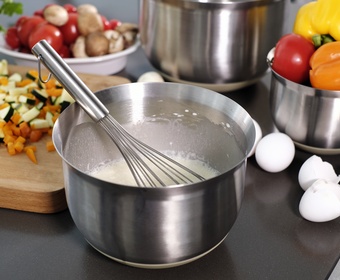About mixing bowls
Basic and functional containers of this kind are indispensable in a well-equipped kitchen. They hardly receive any attention – but they need to fulfil a long list of requirements for the chef to be able to do his or her job.
Mixing bowls share the same ungrateful fate as cooking pots – you only really notice them when they fail your expectations.
Clean surfaces only
Beyond toughness and design, hygiene is also an important factor. Mixing bowls are used for everything from storage to serving and every possible ingredient in the kitchen. Easy cleaning is a must.
Stability when working hard and fast.
– Micke Göransson, chef and food designer on what he looks for in a mixing bowl
Steel hard to beat
Thin, durable steel is a superior material for mixing bowls. It provides a perfect balance between function, weight and resilience.
That clean feeling
Stainless steel is easy to clean and makes a bright, attractive and professional impression in the kitchen. Plastic, however, wears down and has a “greasy” feel even when washed.
No traces in food
A mixing bowl has to withstand electric beaters and other kitchen tools. Stainless steel has what it takes, while plastic risks ending up in your food.
Baking is tough stuff
Major pressure is applied when working the dough in a bowl. Steel can handle it.
Sustainable
Stainless steel meets requirements for long-term sustainability in the kitchen as well as for the environment.
Whip it good
- When making classical emulsions like mayonnaise and aioli, there is less risk of the liquids separating if the egg yolk and the added fat are at the same temperature.
- It is easier to beat egg white to a firm foam if the eggs are at room temperature from the start. The acidity from a few drops of lemon juice will also help the process. Stop when the white foam is perfect, or it will start liquefying again – and use the egg white immediately.
- Vegan tip: Refrigerate a can of coconut milk. Extract the firmest, fattiest part on top and beat as if it were whipping cream.
Form follows function
A raised rim is key to avoid spillage, for example when beating liquids. The rim should also be perfectly curved for pouring out liquidy contents.
Ergonomics
Mixing bowls are repeatedly used during a work shift in the kitchen. They need to be easy to lift and to hold, easy to work with, good for pouring, etc.
Spatula's best buddy
The bowl's contours make a big difference to how well the chef can work with a spatula and other kitchen tools.
Calibrated slope
The right slope on the edge of the bowl helps you pour out any contents without making a mess. Strangely, many mixing bowls out there don’t meet this requirement.
Mixed salad
A professional chef often uses a generously-sized bowl to mix the ingredients in, for example, a salad. Then they are arranged – with care and precision – on the plate.
One bowl is no bowl
Mixing bowls are used for storage, working doughs, mixing dry ingredients, mixing salads, organizing, and more. The kitchen needs several bowls in different sizes.
Stackable saves space
Space for storage can be lacking in professional as well as home kitchens. You can save space by using mixing bowls that can be stacked inside each other.
Care for your bowls
- Stainless steel mixing bowls can take a lot: Boiling water, acidic ingredients, steel kitchen tools, detergents, and more. But after washing they should be dried and stored in a dry place.
- The steel surface will dull with time, especially when using the dishwasher often. This will not affect the bowl’s function and durability.
- Fill with water and leave to soak for a while to soften up any food that has stuck.



